The Ride
December 6
As we made plans for our trip, the big question mark on our itinerary was the journey to Guatemala 's Lago Atitlán from Tikal . A major highway heads south from Tikal , but first it heads east, nearly to the Honduran border, before going south to Guatemala City . From there we would need to backtrack over 90 miles to get to the lake. It was an easy journey, but seemed to go far out of the way. There was an alternative. Some maps showed the road as a narrow red line. On others, the line was broken. Either way, the quality of the road was unknown. In Tikal we asked for recommendations, but no one could tell us exactly what conditions to expect on the road ahead. So we decided to try it.
The first 140 miles flew by. All the roads were paved and in good condition. The hardest part was navigation. Neither map, GPS nor roads were marked or numbered. In small towns the roads turned to narrow, convoluted cobblestone streets, sometimes one way in the wrong direction, before wandering back out of town. At every crossroad or as we left every town we asked for directions, usually seeking at least three different answers before heading on. But the scenery was beautiful, as we climbed into the steep, rock and pine covered mountains of the Guatemalan highlands and we were making good time.
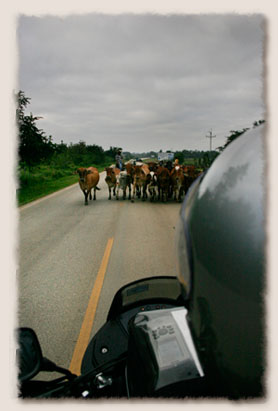
| |
By 8 a.m. we ran into heavy traffic on a road heading south in Guatemala. |
After three hours on the road, it started to rain, our hardest shower of the trip that lasted nearly an hour. But the road continued to be perfect and paved. Our only snag was in Cobán, where the hurricane-swollen Cahabón River had washed out the bridge. A ferry, powered by Yamaha outboards, that displaced water nearly over its sides when a tractor trailer pulled on behind us, took us across. Seven miles south of Cobán we took a left in Santa Cruz Verapaz on the final stretch of road leading to the lake. Traveling the next 70 miles would take us over six hours. 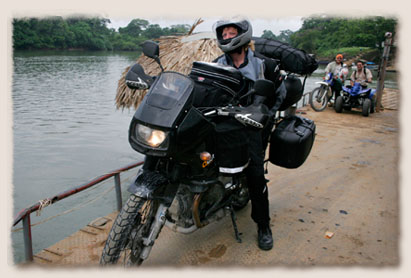
| |
Our road ran into a river with a line of cars, trucks and motorcycles waiting to be ferried across. Apparently the bridge had washed out from hurricanes that hit the area in October. We boarded the free ferry along with a tractor trailer and several other passengers. |
The cobblestone streets of Santa Cruz turned to a dirt road as they left town and the shower we had ran through had turned the road into a rutted, mud. We pressed on. Like the Guatemalan/Belize border road, I expected things to get better quickly. But instead, just when you thought conditions couldn't get any worse, they did. The further we got from Santa Cruz , the deeper and more rutted the mud became as the road began to climb up a fog covered mountain. The locals, who stood on the road's edge, waved goodbye instead of hello as we rode past.
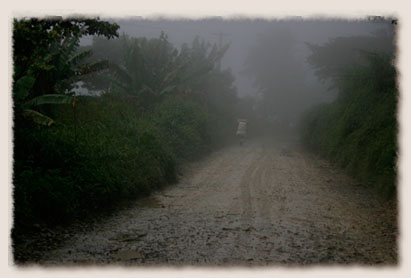
| |
The road was actually worse than it looks in the photo or at least it felt that way as our tires slipped in the mud through the foggy passage. |
If riding a motorcycle in the mud is like tight rope walking, then riding a fully-loaded touring bike with a passenger is like walking a tight rope greased with Crisco blindfolded. The hurricane-damaged road was completely washed out, every piece of gravel and paving stripped from its surface, and interrupted by still-raging streams. We would crawl in first gear around a guardrail-less curve, hoping we could maintain enough speed to make it up the next hill and then inch down the other side, afraid to touch the brakes. Where the mud got deep I relied on the throttle to help the motorcycle's natural tendency to keep its wheels in line, paddling my feet in the mire to maintain a vertical orientation. We slipped and slid, spun and dug our way ahead, the Avon Distanzia tires amazing me in conditions they were never designed for, our progress barely averaging ten miles an hour.
Dealing with slippery traction for two minutes on a motorcycle seems like forever. Two hours seems like an impossible eternity. To keep from panicking and making a mistake or giving in to the urge to quit, your mind shuts out the possibility of things ever getting better and thinks only in the space of one foot ahead of your front wheel. Every stream crossed is a victory. Every fall caught is a survival. I'm sure the mountains and valleys we passed through were beautiful, but if you asked me to describe what they looked like I couldn't tell you. One moment's inattention is all it takes to lose control. Though the weather was cool, I could feel the sweat running down my back inside my riding gear and my muscles twitching from the strain, trying to wrestle control of the front tire from the ruts that tried to take it away from me. Holly sat silently on the back of the motorcycle and my only conversation through our helmet communicators was the grunts and pants from the exertion.
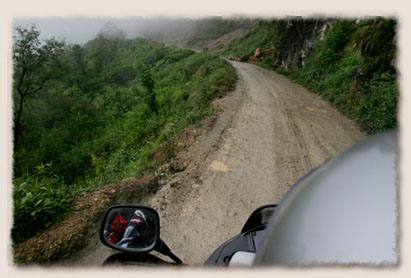
| |
Continuing on, the road went from having houses on either side to hugging the edge of a mountain, still slick with mud. |
Then, unexpectedly, we rounded a corner, crossed a bridge, and the road got better. The road was “better” in the sense of what would have been classified as “horrible” two hours ago was now like the Autobahn, with sporadic gravel to provide traction and break up the mud. We had come 30 miles in two hours. We stopped for gas and to wash the caked mud from the motorcycle in the next village. The station owner said that the road that continued south was “passable” dirt and gravel, but that it would be another hour and a half before we encountered pavement.
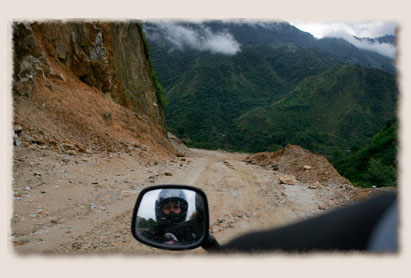
| |
Finally we hit dry roads, but their condition didn't improve. Many had been destroyed from landslides and only temporary narrow passages were carved from the mountain side to let a few brave souls pass. |
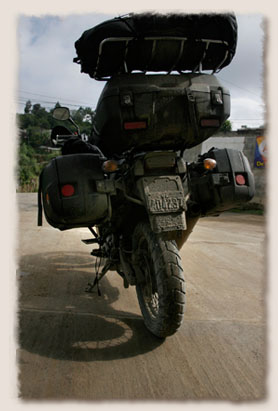
| |
At a small town north of Cunén we stopped for gas and to hose down the bike. |
After surviving the road behind us, I tossed the Guzzi, like a fourteen-year old riding a moped for the first time, on a rutted and steep street in Cunén, while trying to find our way back to the main road. We were almost stopped and the street was so sloped that we didn't fall far. Both machine and riders escaped injury. When you ride every day in bad conditions a fall is not a possibility, it is a historic inevitability. Preparing for the trip, I had figured on such an accident happening and made sure that bike and passengers were well-protected. The only thing damaged was my pride, aching with the painful recognition of mortality. It was the perfect anti-climax of a tough day, my wings melting just when I thought there was no limit to how high I could fly. In my mind, I was already bragging to myself about my riding skills and then having your front end wash out in a street rut was like living through a nuclear blast only to get your fingers blown off by a firecracker.
We didn't reach pavement in an hour and a half as the fun continued after Cunén. Apparently efforts to fix the road were coming up from the south and we ran into the construction. Mud was replaced by heavy equipment and backed up traffic, gravel and dirt piles. The road was still criss-crossed by streams. We were lucky that the road was dry, because had it been wet, motorcycle travel would have been impossible. We continued to inch along, never faster than 20 miles an hour.
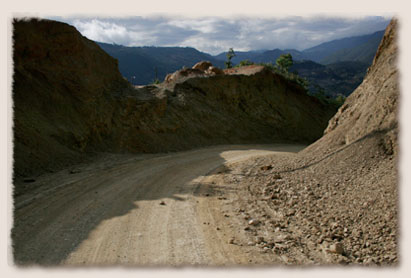
| |
Dustier, rocky roads followed our stop for gas, all of which had been damaged from the storms. |
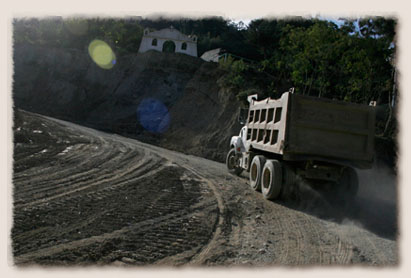
| |
We finally caught up to the construction, which only meant that we now had to face the rough roads with dust flying in our faces. |
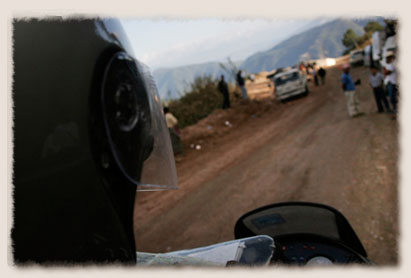
| |
We wait in line with the rest of traffic for a section of the road to be opened so we could reach Panajáchel shortly after dark. |
When we reached the town of Sacapulas , construction ended and we ran into too-good-to-dare-to-believe paved roads. By then it was dark and getting cold as we climbed over 8,000 feet into the Guatemalan highlands. As fatigue sits in on a motorcycle, you can feel your edge slipping away and all the little tasks that riding involves began to feel like they take an impossible effort. Even with good roads, I slowed to over-compensate, struggling to focus out of haze of an exhausted mind and body, trying to stay a half-step ahead of what was going on around us.
We crossed the Pan-American Highway , returning after a week away from the great road south, before heading down into the volcano crater that holds Lago Atitlán. When we finally parked at our hotel in Panajáchel on the lake's edge, we had traveled nearly 300 miles, our longest single day since we crossed the border in Mexico . It was nearly seven o'clock, by which point we had been in the saddle for over 12 hours. We struggled together to unload the bike and drag our luggage up the stairs to our room that we had mercilessly been given on the second floor. An hour later, we were sitting down to a steaming plate and a hot cup of chocolate, a meal that somehow tasted better than anything else we had eaten on our entire trip.
|
|